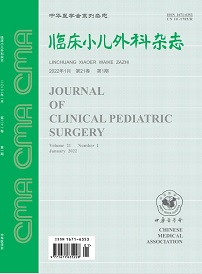Li Chunming,Zhao Fangzhou,Zhao Youquan,et al.Development of a nomogram model to predict postoperative recurrence of upper urinary tract stones in children[J].Journal of Clinical Pediatric Surgery,,():18-24.[doi:10.3760/cma.j.cn101785-202205043-004]
Development of a nomogram model to predict postoperative recurrence of upper urinary tract stones in children
- Keywords:
- Child; Urinary Tract Stones; Recurrence; Independent Risk Factors; Nomogram
- Abstract:
- Objective To investigate the recurrence status of upper urinary tract stones in children,analyze the risk factors influencing stone recurrence,and establish a nomogram to predict recurrence risk. Methods A retrospective analysis was performed on clinical data from 218 pediatric patients who underwent surgical treatment for upper urinary tract stones at Beijing Friendship Hospital between June 2014 and December 2020.Univariate and multivariate Cox regression models were used to screen clinical and follow-up data.Recurrence curves were plotted using the Kaplan-Meier method.A predictive nomogram model was constructed based on identified independent risk factors,and the model’s predictive performance was evaluated. Results Among the 218 patients,157 were male and 61 were female,with a mean age of 4.1±3.4 years.The average follow-up duration was 48.3±21.8 months,and the overall recurrence rate was 16.1% (35/218).Multivariate Cox regression analysis identified four independent risk factors for stone recurrence:age above three years (HR=8.685,95%CI:1.144-65.930),obesity compared to underweight (HR=7.903,95%CI:1.046-59.684),stone density greater than 2000 Hu·cm2 compared to less than 1000 Hu·cm2 (HR=2.842,95%CI:1.171-6.895),and positive preoperative urinary leukocytes (HR=5.172,95%CI:1.681-15.913).A nomogram model was developed using these four risk factors,demonstrating excellent predictive performance with a C-index of 0.853.The area under the curve (AUC) for predicting non-recurrence at one,three,and five years was 0.98,0.96,and 0.84,respectively.Calibration curves closely aligned with ideal curves,indicating good predictive accuracy. Conclusions Pediatric upper urinary tract stones have a high postoperative recurrence rate.Higher age,obesity,large stone density and positive preoperative urinary leukocytes significantly increase recurrence risk.The nomogram model developed in this study provides clinicians with a reliable tool to identify high-risk patients and develop personalized strategies for the prevention and treatment of stone recurrence.
References:
[1] Dalk?l?n? A, Demirkan H, ?z?elik G.Multidimensional analysis of urinary stone diseases in pediatric patients[J]. Sisli Etfal Hastan Tip Bul, 2019, 53(1):46-48.DOI:10.14744/SEMB.2019.32858.
[2] Li Y, Bayne D, Wiener S, et al.Stone formation in patients less than 20 years of age is associated with higher rates of stone recurrence:Results from the Registry for Stones of the Kidney and Ureter (ReSKU)[J]. J Pediatr Urol, 2020, 16(3):373.e1-373.e6.DOI:10.1016/j.jpurol.2020.03.014.
[3] Hernandez JD, Ellison JS, Lendvay TS.Current trends, evaluation, and management of pediatric nephrolithiasis[J]. JAMA Pediatr, 2015, 169(10):964-970.DOI:10.1001/jamapediatrics.2015.1419.
[4] Ingvarsdottir SE, Indridason OS, Palsson R, et al.Stone recurrence among childhood kidney stone formers:results of a nationwide study in Iceland[J]. Urolithiasis, 2020, 48(5):409-417.DOI:10.1007/s00240-020-01179-6.
[5] Kahraman O, Dogan HS, Asci A, et al.Factors associated with the stone-free status after retrograde intrarenal surgery in children[J]. Int J Clin Pract, 2021, 75(10):e14667.DOI:10.1111/ijcp.14667.
[6] Lao M, Kogan BA, White MD, et al.High recurrence rate at 5-year followup in children after upper urinary tract stone surgery[J]. J Urol, 2014, 191(2):440-444.DOI:10.1016/j.juro.2013.09.021.
[7] Medairos R, Paloian NJ, Pan A, et al.Risk factors for subsequent stone events in pediatric nephrolithiasis:a multi-institutional analysis[J]. J Pediatr Urol, 2022, 18(1):26.e1-26.e9.DOI:10.1016/j.jpurol.2021.11.012.
[8] Kuczmarski RJ, Ogden CL, Guo SS, et al.2000 CDC growth charts for the United States:methods and development[J]. Vital Health Stat 11, 2002, (246):1-190.
[9] 张宇, 王小川, 赵方舟, 等.儿童上尿路结石腔内手术后结石复发的影响因素分析[J]. 现代泌尿外科杂志, 2020, 25(12):1079-1084.DOI:10.3969/j.issn.1009-8291.2020.12.008. Zhang Y, Wang XC, Zhao FZ, et al.Risk factors of stone recurrence in children with upper urinary tract calculi after endourological surgery[J]. J Mod Urol, 2020, 25(12):1079-1084.DOI:10.3969/j.issn.1009-8291.2020.12.008.
[10] Tekgül S, Stein R, Bogaert G, et al.European Association of Urology and European Society for Paediatric Urology guidelines on paediatric urinary stone disease[J]. Eur Urol Focus, 2022, 8(3):833-839.DOI:10.1016/j.euf.2021.05.006.
[11] Ang AJS, Sharma AA, Sharma A.Nephrolithiasis:approach to diagnosis and management[J]. Indian J Pediatr, 2020, 87(9):716-725.DOI:10.1007/s12098-020-03424-7.
[12] VntanI·, Vntan S, Tosun H, et al.Metabolic risk factors and the role of prophylaxis in pediatric urolithiasis[J]. J Pediatr Urol, 2021, 17(2):215.e1-215.e6.DOI:10.1016/j.jpurol.2020.12.003.
[13] Taylor EN, Stampfer MJ, Curhan GC.Obesity, weight gain, and the risk of kidney stones[J]. JAMA, 2005, 293(4):455-462.DOI:10.1001/jama.293.4.455.
[14] Maffeis C, Tommasi M, Tomasselli F, et al.Fluid intake and hydration status in obese vs normal weight children[J]. Eur J Clin Nutr, 2016, 70(5):560-565.DOI:10.1038/ejcn.2015.170.
[15] Cambareri GM, Giel DW, Bayne AP, et al.Do overweight and obese pediatric stone formers have differences in metabolic abnormalities compared with normal-weight stone formers?[J]. Urology, 2017, 101:26-30.DOI:10.1016/j.urology.2016.09.011.
[16] Murphy MO, Erpelding SG, Chishti AS, et al.Influence of BMI in nephrolithiasis in an Appalachian pediatric population:a single-center experience[J]. J Pediatr Urol, 2018, 14(4):330.e1-330.e8.DOI:10.1016/j.jpurol.2018.03.024.
[17] Ito K, Takahashi T, Somiya S, et al.Predictors of repeat surgery and stone-related events after flexible ureteroscopy for renal stones[J]. Urology, 2021, 154:96-102.DOI:10.1016/j.urology.2021.02.025.
[18] Li X, Wang LP, Ou LL, et al.Revolution spectral CT for urinary stone with a single/mixed composition in vivo:a large sample analysis[J]. World J Urol, 2021, 39(9):3631-3642.DOI:10.1007/s00345-021-03597-6.
[19] Bauza JL, Pieras EC, Grases F, et al.Urinary tract infection’s etiopathogenic role in nephrolithiasis formation[J]. Med Hypotheses, 2018, 118:34-35.DOI:10.1016/j.mehy.2018.06.002.
[20] 谢华伟, 周辉霞, 马立飞, 等. 两种经脐腹腔镜肾盂成形术治疗儿童肾积水的疗效比较[J]. 中华小儿外科杂志, 2015, 36(10):732-735.DOI:10.3760/cma.j.issn.0253-3006.2015.10.004. Xie HW, Zhou HX, Ma LF, et al.Comparison of two transumbilical laparoscopic pyeloplasties for treating ureteropelvic junction obstruction in children[J]. Chin J Pediatr Surg, 2015, 36(10):732-735. DOI:10.3760/cma.j.issn.0253-3006.2015.10.004.
[21] Cole E, Shaikh N, Forster CS.The pediatric urobiome in genitourinary conditions:a narrative review[J]. Pediatr Nephrol, 2022, 37(7):1443-1452.DOI:10.1007/s00467-021-05274-7.
[22] 阿力木江·阿不都热西提, 张宁, 甘之录, 等.学龄前儿童肾结石成分分析及结石复发相关危险因素分析[J]. 临床泌尿外科杂志, 2021, 36(2):135-138.DOI:10.13201/j.issn.1001-1420.2021.02.012. Abdurexiti ALMJ, Zhang N, Gan ZL, et al.Analysis of components and risk factors of stone recurrence in preschool children[J]. J Clin Urol, 2021, 36(2):135-138.DOI:10.13201/j.issn.1001-1420.2021.02.012.
[23] Kanashiro A, Angerri O.Urinary pH relevance on urolithiasis management[J]. Arch Esp Urol, 2021, 74(1):102-111.
[24] Carvalho M.Urinary pH in calcium oxalate stone formers:does it matter?[J]. J Bras Nefrol, 2018, 40(1):6-7.DOI:10.1590/1678-4685-JBN-2018-00010002.
[25] Bao YG, Tu X, Wei Q.Water for preventing urinary stones[J]. Cochrane Database Syst Rev, 2020, 2(2):CD004292.DOI:10.1002/14651858.CD004292.pub4.
Memo
收稿日期:2022-5-12。
基金项目:北京市医院管理局临床技术创新项目(XMLX201826)
通讯作者:李钧,Email:lljun@yeah.net
